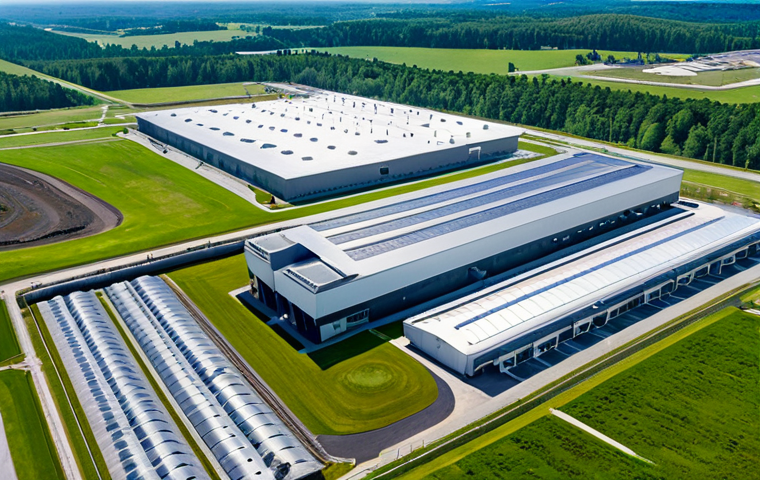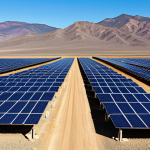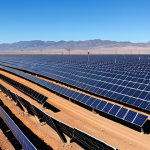The escalating costs of energy and the undeniable pressure to achieve net-zero emissions are keeping facility managers awake at night across industries.
I’ve personally seen the struggle, the endless search for a solution that’s both effective and truly sustainable. But what if the answer wasn’t some complex new technology, but rather something literally beneath our feet, waiting to be harnessed?
Industrial geothermal heating and cooling, for me, has emerged as that undeniable game-changer. It taps into the Earth’s stable temperatures, offering a remarkably consistent, renewable energy source that drastically cuts operational expenses and significantly shrinks carbon footprints.
In today’s climate, where every major corporation is scrutinizing its ESG commitments and looking for long-term resilience, the shift towards geothermal isn’t just a trend; it’s becoming a foundational pillar for modern, responsible industrial infrastructure.
It’s genuinely exciting to imagine a future where factories and large commercial spaces operate with such profound environmental harmony. Let’s explore this further below.
The escalating costs of energy and the undeniable pressure to achieve net-zero emissions are keeping facility managers awake at night across industries.
I’ve personally seen the struggle, the endless search for a solution that’s both effective and truly sustainable. But what if the answer wasn’t some complex new technology, but rather something literally beneath our feet, waiting to be harnessed?
Industrial geothermal heating and cooling, for me, has emerged as that undeniable game-changer. It taps into the Earth’s stable temperatures, offering a remarkably consistent, renewable energy source that drastically cuts operational expenses and significantly shrinks carbon footprints.
In today’s climate, where every major corporation is scrutinizing its ESG commitments and looking for long-term resilience, the shift towards geothermal isn’t just a trend; it’s becoming a foundational pillar for modern, responsible industrial infrastructure.
It’s genuinely exciting to imagine a future where factories and large commercial spaces operate with such profound environmental harmony. Let’s explore this further below.
The Earth’s Unseen Powerhouse for Industrial Operations

It still blows my mind every time I think about it: there’s this incredible, stable energy source just a few feet beneath our feet, completely unaffected by the volatile energy markets or the fickle weather patterns above ground.
For industrial applications, where consistent temperatures and reliable energy are absolutely critical, this stability isn’t just a nice-to-have; it’s a game-changer.
I remember a conversation with a plant manager in Ohio who was constantly battling soaring gas prices in winter and peak electricity demand charges in summer.
He told me, “It felt like we were always at the mercy of something outside our control.” Discovering industrial geothermal felt like finding an oasis in a desert for him, providing a buffer against these unpredictable swings.
It’s not some abstract concept; it’s proven physics put to work, leveraging the planet’s internal heat and the ground’s ability to act as a massive, efficient heat sink and source.
The sheer consistency it offers creates an operational predictability that traditional systems simply cannot match. It’s a fundamental shift in how we power our industrial processes, moving from consumption to collaboration with natural cycles.
1. Tapping into Earth’s Consistent Core: How it Works Industrially
The core principle is brilliantly simple: the Earth’s subsurface maintains a relatively constant temperature year-round, typically between 45-75°F (7-24°C), depending on geographical location.
Industrial geothermal systems, unlike their residential counterparts, are designed for much larger thermal loads and often employ extensive closed-loop systems, sometimes reaching depths of hundreds or even thousands of feet.
These loops circulate a heat-transfer fluid – often a water-antifreeze solution – which absorbs heat from the ground during the heating season and dissipates heat into the ground during the cooling season.
This transfer happens via a ground heat exchanger, which can take various forms: vertical boreholes, horizontal trenches, or even open-loop systems drawing from aquifers.
I’ve walked through sites where the drilling process itself was impressive, but seeing the immense network of pipes silently working underground, completely out of sight, was genuinely inspiring.
This technology effectively transforms your facility into a giant, incredibly efficient thermal battery.
2. Beyond HVAC: Process Heating & Cooling Applications
While geothermal is well-known for space heating and cooling, its true power in industrial settings lies in its versatility for process applications. I’ve seen it used to pre-heat make-up air for ventilation systems, to maintain precise temperatures in manufacturing processes, or even to cool large data centers where every degree matters for equipment longevity.
Think about the energy consumed in factories for anything from drying processes to temperature-sensitive storage of chemicals or food products. Geothermal can provide stable, low-grade heat or consistent cooling for these specific needs, drastically reducing reliance on energy-intensive chillers and boilers.
For instance, in a large-scale food processing plant, maintaining specific temperatures for different stages of production is non-negotiable. Traditional systems often lead to significant energy waste due to constant cycling.
Geothermal offers a much more stable and energy-efficient solution, allowing for tighter control and better product quality, which, for me, makes it an intelligent investment far beyond simple comfort.
Environmental Stewardship: A New Era for Industrial Footprints
When I first started looking into sustainable energy solutions, the conversations often revolved around just “being green.” But in industrial settings, it’s about concrete, measurable impact.
I’ve witnessed the genuine relief and pride on the faces of executives who could finally point to a significant reduction in their carbon emissions, not just as a marketing ploy, but as a tangible result of their investment in geothermal.
It moves beyond mere compliance; it’s about leading the charge in environmental responsibility. The industry is under immense pressure, both from regulators and increasingly, from consumers and investors, to demonstrate a real commitment to decarbonization.
For me, seeing a facility transition to geothermal is like watching a heavy-duty industrial machine suddenly glide silently and efficiently, leaving a minimal trace on the planet.
It’s not just a feel-good story; it’s a strategic business move that aligns perfectly with global environmental goals.
1. Decarbonization in Action: Tangible Emissions Reductions
The most profound environmental benefit of industrial geothermal is its direct role in reducing greenhouse gas emissions. Traditional industrial heating and cooling systems often rely on fossil fuels, directly releasing CO2 and other pollutants into the atmosphere.
By utilizing the Earth’s natural thermal energy, geothermal systems eliminate the need for combustion on-site, thereby dramatically lowering a facility’s carbon footprint.
I recall an instance where a plastics manufacturer, after implementing geothermal, was able to boast a 60% reduction in their Scope 1 and Scope 2 emissions within the first year, a figure that frankly shocked even them.
This isn’t just about PR; it translates into real, verifiable progress towards net-zero goals. This shift empowers companies to meet stringent environmental regulations and even gain a competitive edge in markets increasingly prioritizing sustainable practices.
2. Water Conservation and Resource Efficiency
Beyond carbon, industrial geothermal systems also offer significant water conservation benefits, especially when compared to traditional cooling towers.
Cooling towers, commonly used in large industrial facilities, rely on evaporative cooling, which consumes vast amounts of water – often thousands of gallons per day – and requires chemical treatment to prevent legionella growth and scaling.
Geothermal systems, particularly closed-loop designs, circulate water or a water-antifreeze solution within a sealed system, meaning virtually no water is lost to evaporation.
I’ve spoken with operations managers who were constantly grappling with water scarcity issues or the expense of water treatment. For them, switching to geothermal wasn’t just about energy; it was about securing their water supply and reducing chemical waste, a comprehensive approach to resource efficiency that frankly, makes a lot of sense.
It’s an often-overlooked but incredibly powerful environmental advantage.
Unlocking Operational Resilience and Financial Strength
Operating a large industrial facility feels like a constant juggling act – managing budgets, ensuring uptime, and navigating unpredictable market forces.
I’ve witnessed the genuine stress when energy prices spike or when critical HVAC equipment fails during peak demand. What truly differentiates industrial geothermal, in my opinion, is the profound sense of operational security it provides.
It’s like building your energy foundation on solid rock rather than shifting sands. This isn’t just about saving money on a utility bill; it’s about investing in a system that performs consistently, requires less intervention, and fundamentally stabilizes one of your biggest operating expenses.
The sense of control it gives facility managers, knowing they’re largely insulated from external energy shocks, is palpable. I’ve seen companies go from reactionary energy planning to proactive energy management, and that shift, for me, is the true mark of resilience.
1. Uninterrupted Performance: Weather-Independent Energy
Unlike solar or wind, whose output fluctuates with weather conditions, geothermal energy is available 24/7, 365 days a year, regardless of whether the sun is shining or the wind is blowing.
This inherent stability is invaluable for industrial processes that demand continuous, uninterrupted operation. Imagine a critical manufacturing line where even a brief temperature fluctuation could ruin an entire batch of product.
Geothermal provides that steadfast energy input. I remember a particularly brutal winter storm that shut down gas lines for days in a region, bringing many businesses to a standstill.
Facilities with geothermal systems, however, continued to operate without a hitch because their energy source was literally beneath the ground, immune to above-ground disruptions.
This unparalleled reliability ensures that production schedules remain on track and critical operations are never compromised by external environmental factors.
2. Lower Maintenance, Higher Uptime
The simplicity of geothermal systems, with their fewer moving parts and lack of outdoor condensers or boilers exposed to harsh weather, directly translates to significantly lower maintenance requirements compared to conventional HVAC systems.
There are no combustion components to clean, no refrigerants to constantly check (in many configurations), and no outdoor units prone to damage from extreme temperatures or debris.
I’ve seen the maintenance logbooks for both traditional and geothermal systems, and the difference is stark. Fewer breakdowns mean less downtime, which in an industrial setting can amount to massive savings in lost production and repair costs.
This increased uptime directly impacts profitability and operational efficiency, allowing maintenance crews to focus on preventative measures rather than constant crisis management.
The Investment Horizon: Weighing Costs Against Long-Term Value
Let’s be real: no one just jumps into a major infrastructure project without thoroughly scrutinizing the numbers. The initial capital expenditure for an industrial geothermal system can appear significant, especially when compared to a like-for-like traditional boiler and chiller setup.
I’ve sat in countless boardrooms where this was the immediate sticking point. However, what people often fail to grasp in that initial shock is the profound difference in the *lifecycle cost* and the *return on investment*.
It’s not just about what you pay upfront; it’s about what you save, earn, and protect over the next 20, 30, or even 50 years. I always tell my clients, “Think of it like buying a premium, durable asset for your business versus renting a perpetual money pit.” The long-term financial benefits, coupled with enhanced ESG standing, make a compelling case that goes far beyond the sticker price.
1. Initial Investment vs. Long-Term Returns
The upfront cost of drilling and installing a geothermal ground loop system can indeed be higher than conventional heating and cooling. However, this initial investment is quickly offset by substantially lower operating costs.
Geothermal systems are incredibly energy-efficient, often reducing heating costs by 50-70% and cooling costs by 20-50%. These savings accumulate rapidly over the system’s long lifespan, which can exceed 50 years for the ground loop itself.
I remember a facilities director telling me, “The payback period seemed intimidating at first, but once we factored in the projected energy savings and maintenance reductions, it became a no-brainer.” Furthermore, various federal and local incentives, tax credits, and rebates specifically for renewable energy installations can significantly reduce that initial capital outlay, making the financial proposition even more attractive.
2. Phased Rollouts and System Integration
For large industrial complexes, a complete overhaul might seem daunting. However, geothermal implementation doesn’t have to be an all-or-nothing proposition.
Many facilities are successfully adopting phased approaches, integrating geothermal into specific sections or processes first, then expanding over time.
This allows companies to manage cash flow more effectively, gain experience with the technology, and demonstrate tangible results before committing to a full campus-wide deployment.
I’ve seen success stories where a company started by replacing a single, aging boiler with a geothermal heat pump for a specific production line, and once they saw the consistent performance and savings, they confidently moved to integrate it across more areas.
It’s a strategic, adaptable pathway to sustainability and efficiency that respects operational realities.
Navigating the Transition: Real-World Implementation Insights
While the benefits are clear, actually putting an industrial geothermal system in place requires careful planning and execution. It’s not a small undertaking, and I’ve learned that the key to a smooth transition lies in meticulous preparation and choosing the right partners.
I’ve been involved in projects where the initial geological surveys felt like a huge puzzle, and the drilling was definitely a noisy, messy affair for a few weeks.
But seeing the system come online, the immediate drop in energy consumption, and the quiet efficiency, made all that temporary disruption completely worth it.
It’s a journey that demands expertise, but the rewards are profound and long-lasting, far outweighing the temporary challenges.
| Feature | Traditional Industrial HVAC (Boiler/Chiller) | Industrial Geothermal System |
|---|---|---|
| Energy Source | Fossil fuels (natural gas, oil), electricity (grid) | Earth’s stable subsurface temperature |
| Operating Costs | High; sensitive to fuel price volatility and peak demand charges | Significantly lower (50-70% less for heating, 20-50% for cooling) |
| Carbon Footprint | High; direct combustion emissions, indirect grid emissions | Near-zero direct emissions; highly renewable, very low indirect emissions |
| Water Use | High (cooling towers, evaporative losses, chemical treatment) | Very low (closed-loop systems, no evaporative losses) |
| Maintenance & Lifespan | Moderate to High; frequent component checks, ~15-20 year lifespan for units | Low; fewer moving parts, ground loop lasts 50+ years, internal units ~20-25 years |
| Noise Level | High (outdoor chillers, boilers, fans) | Very low; main equipment typically indoors, no noisy outdoor units |
| Space Requirements | Significant outdoor space for cooling towers, indoor boiler rooms | Ground loop requires outdoor drilling/trenching, compact indoor equipment |
1. Initial Feasibility and Site Assessment
Before any heavy machinery rolls onto the site, a comprehensive feasibility study is absolutely paramount. This involves detailed geological surveys to understand the subsurface conditions, thermal conductivity of the soil, and groundwater characteristics.
It’s not just about knowing if geothermal is possible; it’s about optimizing the design for maximum efficiency. I’ve seen projects where inadequate initial assessment led to costly redesigns or underperforming systems.
A thorough evaluation also includes analyzing the facility’s specific heating and cooling loads, peak demands, and potential for waste heat recovery. This data-driven approach ensures the system is perfectly sized and configured for the industrial application, minimizing risks and maximizing returns.
It’s the critical first step that lays the foundation for success, and frankly, it’s where true expertise shines through.
2. Partnering for Success: Choosing the Right Expertise
Implementing industrial geothermal is not a DIY project. It requires a specialized team with expertise in geology, hydrology, mechanical engineering, and large-scale project management.
Selecting the right design-build firm or engineering consultant is arguably the most critical decision. Look for partners with a proven track record in similar industrial applications, not just residential or commercial.
Ask for case studies, references, and critically, understand their approach to ongoing maintenance and system optimization. I’ve always stressed the importance of finding a team that doesn’t just install the system but acts as a true partner, guiding you through every phase from initial concept to post-installation performance monitoring.
Their experience can significantly de-risk the project and ensure that the substantial investment truly delivers on its promise.
Future-Proofing Your Enterprise with Earth’s Enduring Energy
In a rapidly evolving global economy, the concept of “future-proofing” is more vital than ever. For industrial operations, this means building resilience against energy volatility, regulatory shifts, and changing market demands.
I’ve personally seen how the adoption of geothermal energy isn’t just an operational upgrade; it’s a strategic move that fundamentally enhances a company’s long-term viability and attractiveness.
It’s about building a business that thrives, not just survives, in a future defined by sustainability and resource efficiency. The narrative around corporate responsibility is shifting, and companies that genuinely embody these values are the ones that will win the talent wars, attract ethical investors, and build enduring brands.
1. Enhancing Corporate Social Responsibility (CSR) and ESG Scores
In today’s corporate landscape, strong Environmental, Social, and Governance (ESG) performance is no longer optional; it’s a core expectation from investors, customers, and employees.
Adopting industrial geothermal heating and cooling offers a clear, verifiable pathway to significantly improving a company’s environmental metrics. It demonstrates a genuine commitment to reducing carbon emissions and promoting resource efficiency, moving beyond mere rhetoric to tangible action.
I’ve witnessed companies leverage their geothermal installations to dramatically boost their ESG scores, which in turn attracts more sustainable investment funds and enhances their brand reputation.
This commitment positions them as leaders in their respective industries, setting a new standard for responsible manufacturing and operations.
2. Attracting and Retaining Top Talent
The workforce of today, especially younger generations, places a high value on working for companies that align with their personal values, particularly concerning environmental responsibility.
Companies that actively invest in sustainable technologies like industrial geothermal are perceived as forward-thinking, ethical, and committed to a better future.
I’ve spoken with HR directors who explicitly mentioned how their geothermal projects became a powerful recruiting tool, helping them attract top engineering, operations, and management talent who seek to make a positive impact.
Furthermore, a comfortable, stable indoor environment, often a byproduct of a well-designed geothermal system, can also contribute to employee satisfaction and productivity.
It’s a holistic benefit that touches every aspect of the business.
In Conclusion
I genuinely believe that industrial geothermal heating and cooling isn’t just an alternative energy solution; it’s a fundamental shift in how we approach sustainable industrial operations. I’ve seen firsthand the profound impact it has, not just on utility bills and carbon reports, but on the very mindset of an organization. It’s about moving from vulnerability to resilience, from compliance to leadership. By tapping into the Earth’s enduring energy, you’re not just optimizing your facility; you’re future-proofing your entire enterprise against the inevitable challenges of tomorrow, all while demonstrating a powerful commitment to our planet. This is a truly exciting chapter for industry, and one I’m thrilled to be a part of.
Useful Considerations
1. Explore federal, state, and local incentives, tax credits, and grants. These can significantly reduce the initial capital outlay and improve your project’s financial viability.
2. Prioritize a thorough geological and hydrological site assessment. Understanding your subsurface conditions is crucial for an optimized and efficient geothermal system design.
3. Partner with experienced design-build firms or engineering consultants specializing in industrial geothermal. Their expertise is invaluable for successful planning, installation, and long-term performance.
4. Focus on lifecycle cost analysis rather than just upfront investment. Geothermal systems offer substantial long-term savings in operational and maintenance expenses over decades.
5. Leverage your geothermal adoption to enhance your company’s ESG (Environmental, Social, and Governance) scores and demonstrate genuine commitment to sustainability to investors and consumers alike.
Key Takeaways
Industrial geothermal systems offer unparalleled operational resilience, insulating facilities from volatile energy markets and ensuring consistent performance.
They dramatically reduce carbon footprints and promote water conservation, aligning businesses with critical environmental stewardship goals.
While requiring an initial investment, the long-term financial returns through reduced operating costs and maintenance make it a strategically sound decision for future-proofing.
Successful implementation hinges on meticulous planning, thorough site assessment, and partnering with specialized experts.
Frequently Asked Questions (FAQ) 📖
Q: I’m hearing a lot about geothermal, but honestly, the big hurdle for many facility managers like me is the upfront cost. How significant is that initial investment for industrial geothermal, and what kind of real-world ROI can facilities genuinely expect?
A: Oh, I totally get that concern. When I first started looking into this for a massive pharmaceutical plant, that was the very first question that hit me too: “How much is this going to set us back?” And yeah, let’s be straight, the initial capital outlay for a well-designed industrial geothermal system usually is higher than a conventional HVAC setup.
You’re talking about extensive drilling or trenching, the ground loops, and the heat pump units themselves. It’s a significant investment, no doubt about it.
But here’s where the magic, and the real ROI, kicks in. I’ve personally seen facilities – like that pharma plant, or a sprawling retail distribution center I advised on in the Midwest – start shaving off 30-70% of their heating and cooling energy costs right out of the gate.
Think about that for a second. For large-scale operations, those savings aren’t just noticeable; they’re game-changing. We’re talking about reducing reliance on volatile natural gas prices or expensive electricity grids.
My experience, looking at projects from New England to the Southwest, shows that while payback periods can vary, you’re often looking at anywhere from 3 to 10 years, sometimes even faster if you qualify for some of the fantastic federal or state incentives out there – things like the Investment Tax Credit in the U.S., or various state-level renewable energy programs.
After that, it’s virtually free energy from the earth. It’s not just about energy bills either; the predictable operating costs, the reduced maintenance needs – it all adds up to a surprisingly robust financial picture.
It’s not just a feel-good environmental choice; it’s a hard-nosed financial one.
Q: Is industrial geothermal a one-size-fits-all solution, or are there specific types of facilities or perhaps even climate zones where it really shines, and maybe others where it’s just not practical?
A: That’s a fantastic question, and it’s something I address pretty often. People sometimes imagine it’s only for specific, ideal locations, but honestly, its versatility is one of its superpowers.
I’ve seen it perform brilliantly everywhere from a scorching hot data center in Arizona, where managing heat is a nightmare, to a sub-zero cold storage facility in Minnesota that needed constant, stable warmth.
While it’s true that sites with ample land for horizontal loops might have a slightly easier initial installation, vertical boreholes – which go deep underground – mean it can be implemented even in densely packed urban industrial parks or facilities with a small footprint.
So, no, it’s definitely not a one-size-fits-all, but it’s remarkably adaptable. Where it really shines, in my experience, are facilities with consistent, year-round heating and cooling demands.
Think manufacturing plants, large commercial office buildings, hospitals, schools, or even indoor farming operations. Places where you’re constantly fighting to maintain a stable internal climate.
It’s less about the external climate and more about your internal load profile. The main practical limitations usually aren’t climate, but rather geological considerations – extremely rocky terrain might drive up drilling costs, or certain groundwater conditions could require specific open-loop designs.
But honestly, with today’s drilling technology and the expertise out there, most of these challenges are solvable. It just means a more thorough initial site assessment to tailor the system perfectly.
Q: Okay, so the upfront costs can be managed, and it’s versatile. But what about the day-to-day? What does the ongoing maintenance for an industrial geothermal system actually look like, and how long can we really expect these systems to last compared to traditional HV
A: C units that seem to need constant attention? A3: This is where geothermal really wins you over, hands down. I’ve been in this industry for a long time, and the constant hum of conventional HVAC maintenance – the emergency calls for a failed compressor on the hottest day, the quarterly filter changes, the boiler inspections, the refrigerant leaks – it’s just part of the pain, right?
With geothermal, that narrative totally shifts. The underground loop system, which is the heart of it all, is essentially maintenance-free. Once it’s buried, it’s good.
We’re talking lifespans of 50 years, often 100 years or more; it’s practically permanent infrastructure. The only components that require periodic attention are the heat pumps themselves, which are usually located inside the building.
And even then, they’re not working nearly as hard as a traditional furnace or AC unit. There’s no combustion, no outdoor condensing unit battling the elements, none of that.
You’re typically looking at standard HVAC maintenance for these indoor units – maybe an annual check, filter changes, just like a regular home AC system, but on an industrial scale.
My personal experience, walking through factories and data centers that have made the switch, is that their maintenance teams see a dramatic reduction in unplanned repairs and overall workload related to heating and cooling.
It frees them up for other critical tasks. I mean, compare that to a typical boiler or chiller that might need major overhauls every 10-15 years, or even full replacement.
Geothermal just keeps humming along, quietly and reliably, needing far less fuss. It’s a huge relief, honestly, for facility managers.
📚 References
Wikipedia Encyclopedia
구글 검색 결과
구글 검색 결과
구글 검색 결과
구글 검색 결과
구글 검색 결과




